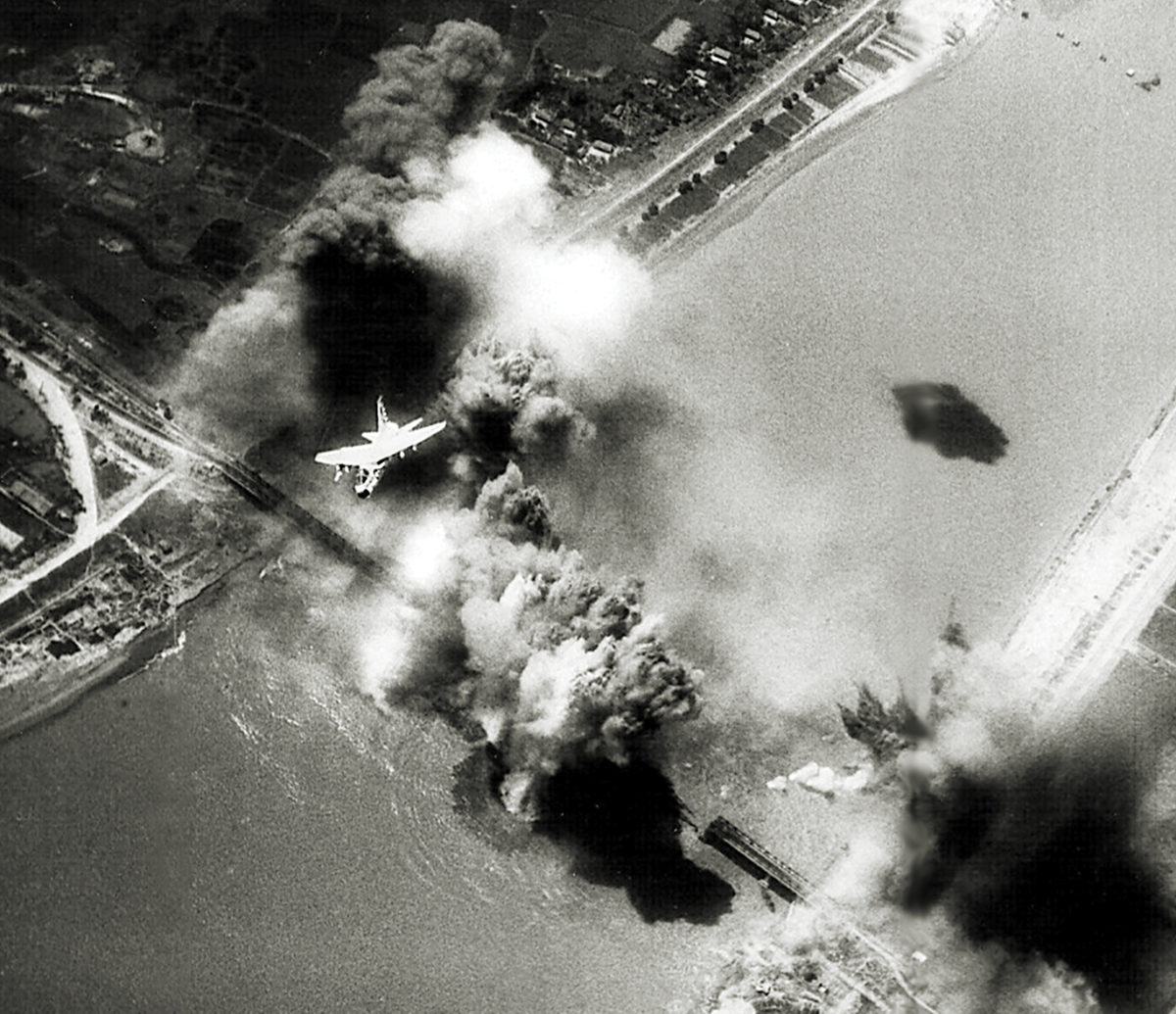Among other responses to North Vietnam’s invasion of South Vietnam on March 30, 1972, U.S. President Richard Nixon announced on May 8 the full resumption of bombing North Vietnam’s supply centers and logistical routes. That same day, McDonnell F-4 Phantom IIs of both the U.S. Air Force and Navy battled Mikoyan-Gurevich fighters of the Vietnam People’s Air Force, which included their first encounter with Shenyang J-6s (Chinese license-built MiG-19s).
Escorting a strike on the Thac Ba hydroelectric plant, Maj. Barton P. Crews of the 13th Tactical Fighter Squadron, 432nd Tactical Reconnaissance Wing, with Capt. Keith W. Jones Jr. serving as his weapons systems operator (WSO), got into a confused dogfight with J-6s of the 925th Fighter Regiment (FR) near Yen Bai airfield, during which he saw a yellow parachute and got subsequent confirmation from U.S. intelligence that the enemy fighter was down out of control. On the VPAF side, Nguyen Ngoc Tiep was credited with an F-4 while Nguyen Hong Son reportedly released his brake chute by mistake, then jettisoned his auxiliary fuel tanks and shot down another F-4 before landing. Neither VPAF claim has a corresponding American loss.
Day of Aces
A more clear-cut victory that day was a MiG-21MF hit by one of two AIM-7E-2 Sparrow radar-guided air-to-air missiles launched by Maj. Robert A. Lodge and 1st Lt. Roger C. Locher of the 555th TFS, 432nd TRW. Its pilot, Vo Si Giap of the 921st FR, tried to force-land when he saw he was coming down on Thuong Trung Secondary School. He veered off and made for a water-filled ditch but crashed. Although he was rushed to Military Hospital 108 near Hanoi, he died of his injures on May 11. Elsewhere, escorting a strike on the Ho Chi Minh Trail, F-4J crewmen Lt. Randall H. Cunningham and Lt. j.g. William P. Driscoll Jr. of fighter squadron VF-96 of the aircraft carrier USS Constellation, after a difficult scrap with MiG-17s of the 923rd FR, hit one with an AIM-9G Sidewinder heat-seeking AAM and were credited with their second confirmed victory of the war. On May 9, the U.S. Navy carried out Operation Pocket Money. While a diversionary force of 17 aircraft from the carrier USS Kitty Hawk bombed the Nam Dinh railroad siding, another force of Navy and Marine planes from USS Coral Sea dropped 36 mines into Haiphong harbor.
These aerial skirmishes were just a prelude to the all-out bombing campaign called Operation Linebacker. It began in earnest on May 10, 1972, with both sides committing all their air assets in a sprawling succession of aerial duels.
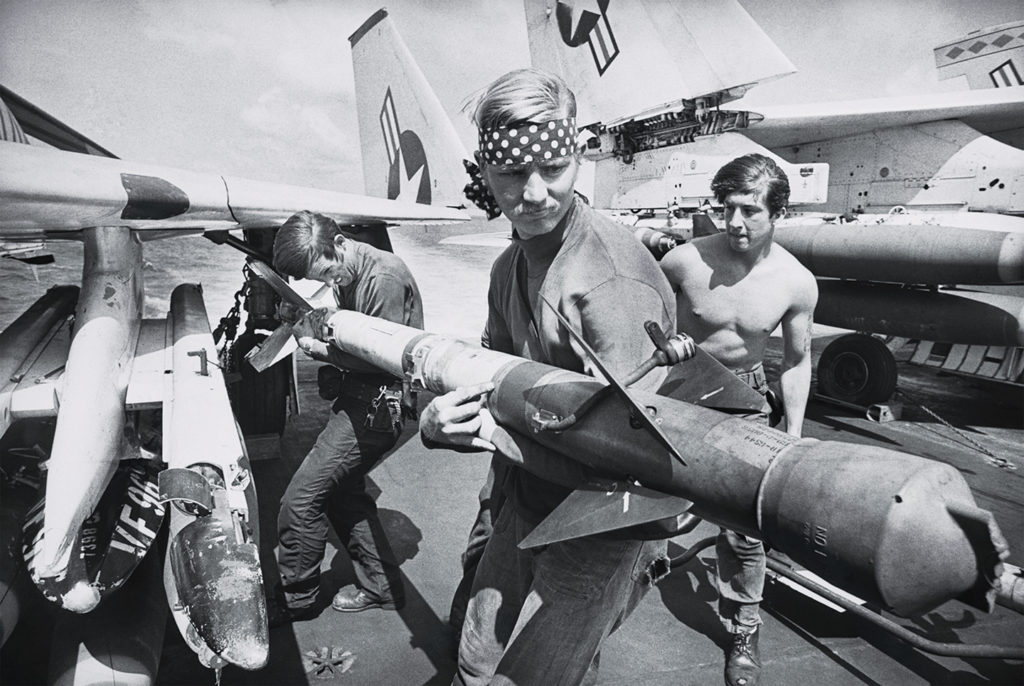
May 10 also became a “day of aces.” The U.S. Navy’s Randy Cunningham and Willy Driscoll became the first American airmen to achieve ace status in the Vietnam War, while VPAF aces Dang Ngoc Nhu and Le Thanh Dao added one each to their scores. Two USAF aces-to-be, Capt. Richard Stephen Ritchie and his WSO, Capt. Charles Barbin DeBellevue, claimed their first successes. The Americans’ attack plan that day displayed the differences by which their two services approached Linebacker. The Navy sortied at 8:00 a.m. with the first of three Alpha (attack) strikes on var-ious coastal installations, particularly Haiphong, launched at four-hour intervals from Constellation, Kitty Hawk, and Coral Sea.
Each carrier’s Alpha strike consisted of six Grumman A-6 Intruders, 10 Vought A-7 Corsair IIs, nine F-4Js flying escort, four other F-4Js assigned to suppress anti-aircraft artillery (AAA), and two “Iron Hand” A-7s disrupting the enemy’s surface-to-air missiles, or rather, the radar that guided the SAMs.
Targeting Hanoi
The Air Force’s main target was the North Vietnamese capital of Hanoi and involved one strike force in a two-pronged approach, starting at 9:20 a.m. Its components included a MiGCAP (combat air patrol) of four F-4Ds from the 555th TFS, with eight other Phantoms of the 8th TFW dropping metallic chaff to confuse North Vietnamese radar, while the strike force itself consisted of four more F-4s of the 555th TFS and four from the 13th TFS, five Republic F-105G “Wild Weasels” of the 17th TFS for SAM suppression, and 16 F-4Ds of the 8th TFW armed with precision guided munitions—four with electro-optically guided bombs and 12 with laser-guided bombs.
In addition to a new generation of high-tech bombing ordnance, some of the Phantoms were fitted with the new APX-81 Combat Tree, radar capable of reading North Vietnamese MiGs’ SRO-2 transponders out to 60 miles at all altitudes, giving them invaluable advance knowledge of the enemy’s movements.
Also present in some USAF units was the F-4E, the first Phantom with a nose-mounted 20mm cannon to supplement its AAMs. By then, both services had been training their fighter pilots on how to most effectively engage MiGs through the Navy’s Top Gun and the Air Force’s Fighter Weapons School.
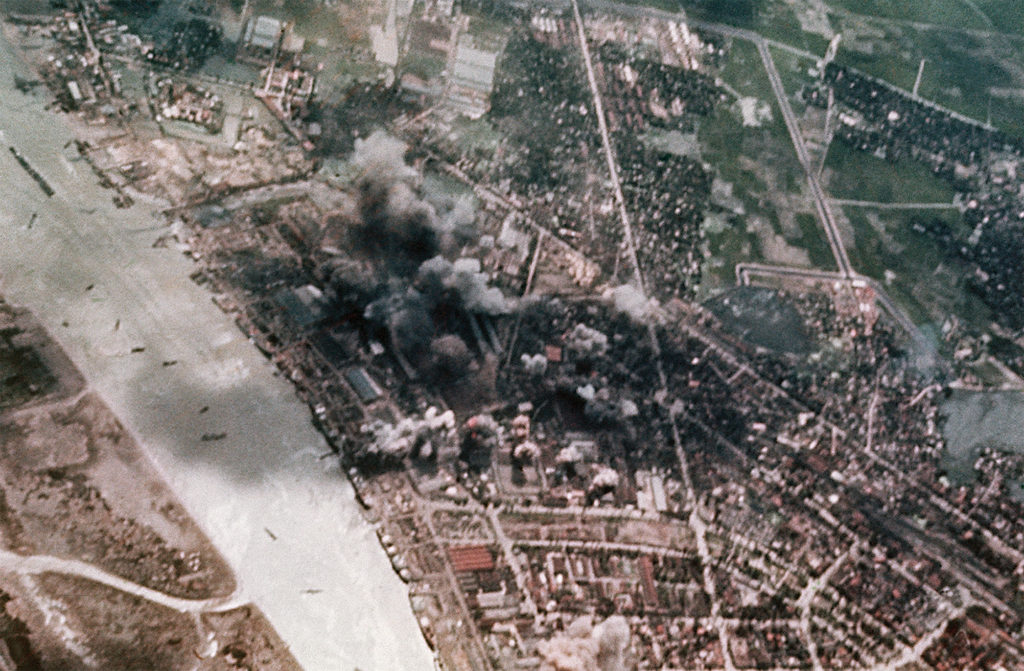
In comparison to the advances made in American weaponry, those in North Vietnam’s defenses were primarily modified SA-2 SAMs, backed by new missile launch vans with an optical guidance system as a backup in case the radar was jammed. These were still part of a long-standing triad strategy in which their ground control intercept (GCI) coordinated the SAMs, the MiG fighters, and the AAA to make the most of their performances at high, medium, and low altitudes, respectively—at least in theory. In practice, the three defensive elements overlapped on this occasion, resulting in confusion as to which weapon was engaging a particular American aircraft.
Fleeing Phantoms
As far as aircraft were concerned, by February 1972 the VPAF had doubled its fighter force to 120, although only a quarter of it could be called state-of-the-art. These were the MiG-21MFs delivered to the 921st Fighter Regiment based at Gia Lam and Bach Mai airfields, which passed on its older but still capable MiG-21PFMs to a new unit, the 927th FR at Phuc Yen and Noi Bai. Supplementing these were two types dating to the 1950s.
The veteran 923rd FR, based at Kep, still used the MiG-17, a nimble but obsolescent subsonic fighter. Between 1968 and 1969 the 925th FR, based at Yen Bai, had received a total of 58 Chinese-built J-6s, Mach 1-capable but difficult to fly and so unpopular with their pilots that the VPAF avoided using them until Operation Linebacker made it necessary to commit all available resources.
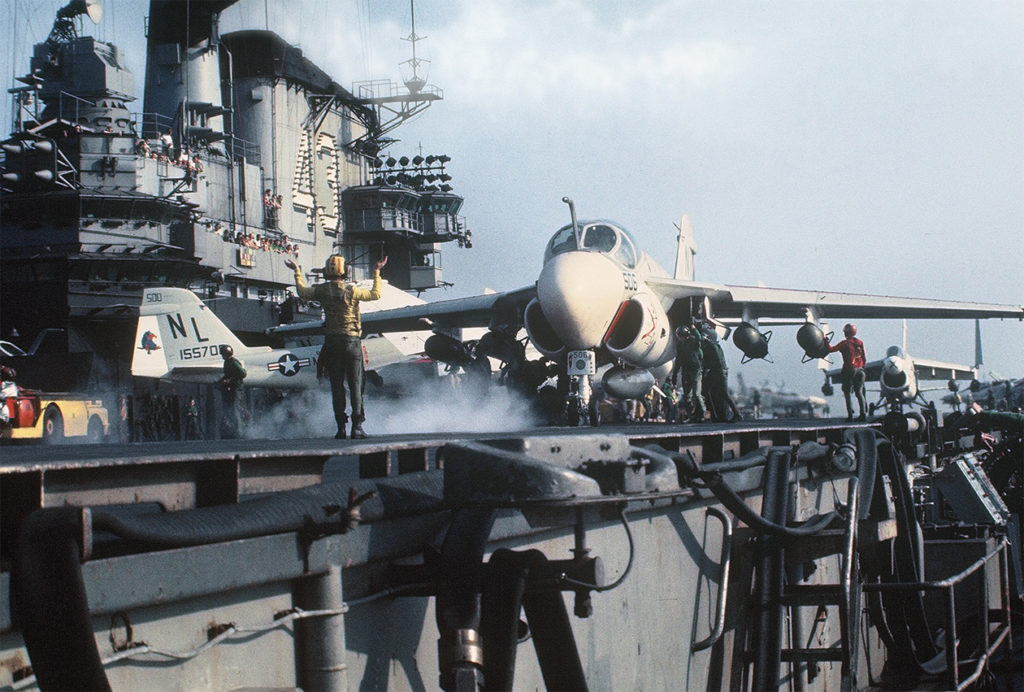
As information about the Americans’ approach reached them, the North Vietnamese focused their defenses—including all four fighter regiments—on the area southeast of Hanoi, as well as Yen Bai airfield and the Thac Ba hydroelectric plant. At 8:30 a.m. the first American attacks took place around Haiphong, Pha Lai, Son Dong, Bac Ninh, and Luc Ngan. The first aerial clash occurred as two MiG-21MFs of the 921st FR, taking off from Kep, were jumped by two F-4Js of Constellation’s VF-92, which made a supersonic pass down the runway, engaging the MiGs in a high-speed, low-altitude fight.
Hit by a Sidewinder launched by Phantom crew Lt. Curt Dosé and Lt. Cmdr. James McDevitt, Nguyen Van Ngai’s MiG blew up. “There was no ejection,” Dosé reported. Dang Ngoc Nhu, an experienced pilot with three airplanes and three unmanned reconnaissance drones to his credit, evaded the Sidewinders until the Americans broke off their attack as two new MiG-21s flew through the fight. American intelligence reported that those fighters’ pilots were speaking Russian.
Nhu turned back after the fleeing Phantoms and claimed an R-3S missile hit on one. Dosé reported that: “We saw and evaded this missile which was fired at the lead F-4J.” Nhu’s second AAM failed to leave the right pylon and he disengaged, landing at Noi Bai to be credited with his seventh and final victory, although VF-92 recorded no F-4s lost in that fight. It was hardly the only such case that day.
“Too Good To Be True”
The next clash involved the USAF as two MiGCAP flights of the 555th TFS entered North Vietnamese airspace at 9:20 a.m. At 9:45 “Oyster Flight,” led by Maj. Bob Lodge, engaged MiG-21MFs of the 921st FR over Kep.
Piloting Oyster Flight 3 was Steve Ritchie, who had previously flown 95 missions in 1968 as a “Fast FAC” (forward air controller) out of Da Nang with the 480th and 489th Tactical Fighter Squadrons of the 366th TFW. After training in the Air Force Fighter Weapons School, he returned in January 1972, assigned to the “Triple Nickel” squadron at Udorn Royal Thai Air Force Base.
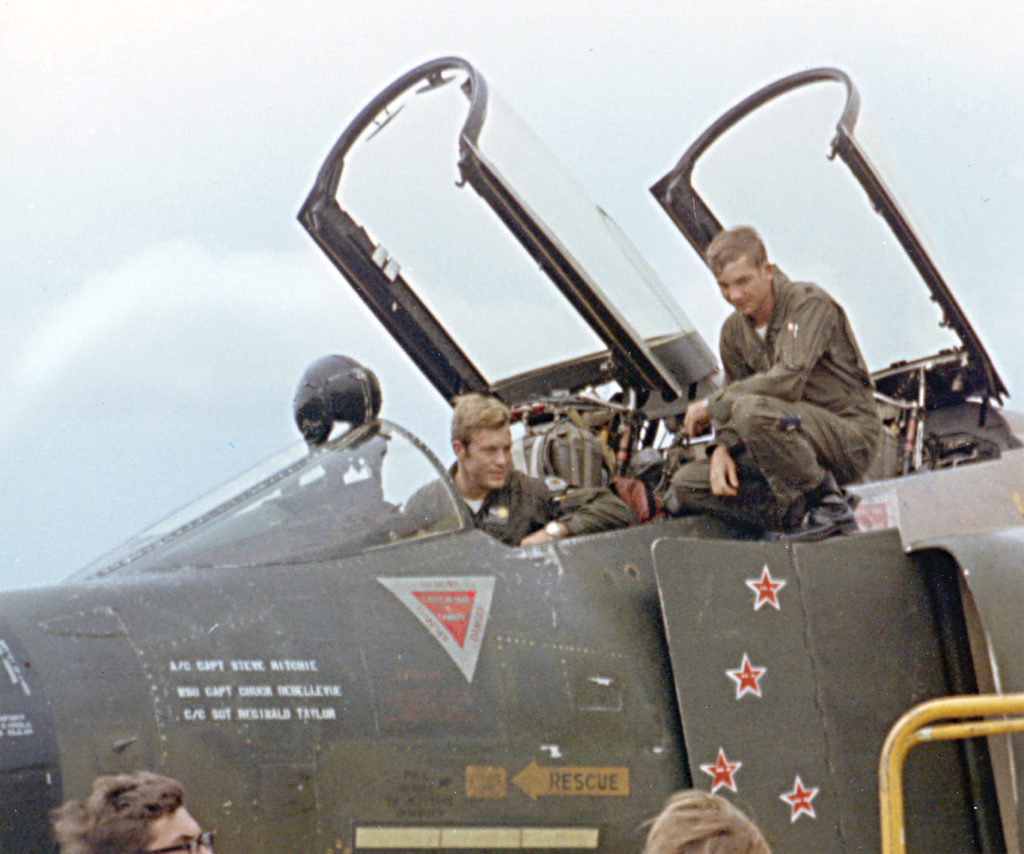
“Approaching our planned orbit some 25 to 30 miles west of Hanoi,” Ritchie said, “we stayed below 300 feet as planned and continued radio silence until we electronically spotted a flight of four MiG-21s in orbit northwest of Hanoi. Intelligence had predicted this situation, and our plan was to wait until the MiGs departed their holding pattern to attack our strike force as it approached from the southwest. We would then ‘pop up’ to meet the Soviet-built fighters. Right on schedule, the MiG-21s departed orbit, and we rolled out on a northerly heading, pointing our radar sensors skyward to achieve full system radar lock-ons at 15 miles. Our adrenaline surged as the battle developed at a closing rate of some 1,200 miles per hour.
“The computer for our Sparrow radar missile flashed that we were in range and as briefed, our first two jets—Oyster One with Bob Lodge and Roger Locher, and Oyster Two piloted by John Markle and Steve Eaves—fired head-on at seven miles. Within seconds, fireballs and smoke trails filled the air, and debris was falling all around us. Two MiGs had been destroyed. Lodge and I, in Oyster One and Three, immediately turned our fighters as hard as possible to achieve rear-quarter positions on the remaining two MiGs.
“I locked on to the third MiG using the auto-acquisition switch on the left throttle and fired two Sparrows at a range of 6,000 feet. The second missile exploded under the fuselage of the North Vietnamese fighter and the pilot bailed out as his craft burst into flames at 15,000 feet above sea level.”
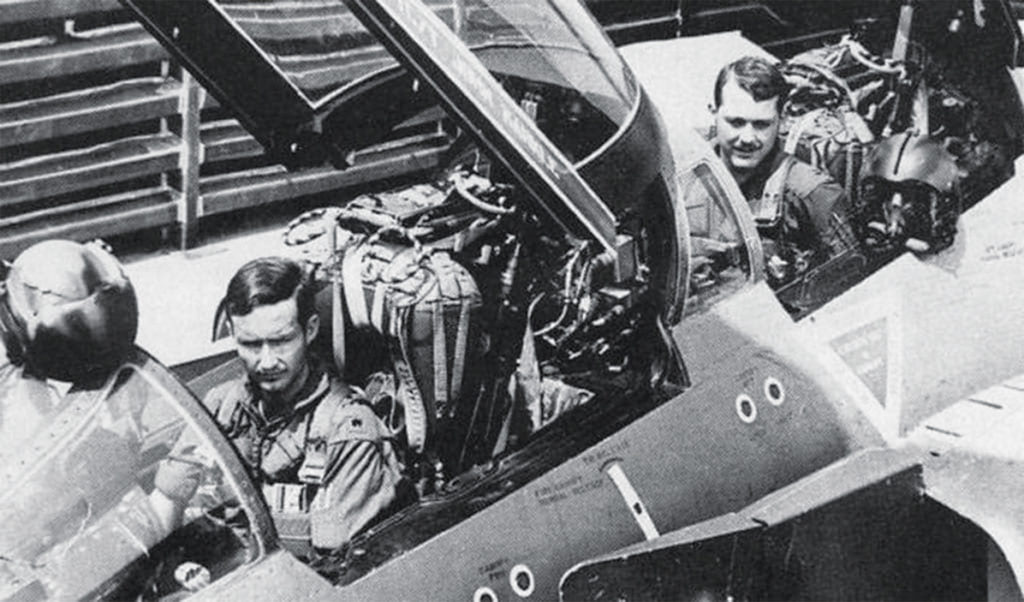
North Vietnamese accounts state that MiG-21MFs of the 921st FR, scrambling up from Kep at 9:44 a.m. were ambushed. Nguyen Cong Huy’s plane was damaged by an AIM-7 AAM, but managed to limp back to Noi Bai, though he was probably credited either to Lodge and Locher or to Capt. John D. Markle and Steve D. Eaves. The VPAF also claimed that Cao Son Khau, after downing an F-4, was hit by a missile—probably launched by Ritchie—and ejected, only to die of injuries shortly after.
“What a great day it was going to be—a perfectly planned, perfectly executed mission, resulting in four American victories,” Ritchie recalled. “But it was too good to be true.” Having scored his third victory, Lodge was positioning to attack the remaining MiG-21 when he was suddenly attacked from above and behind by a cannon-armed J-6. “Within seconds,” said Ritchie, “the Phantom burst into flames and rolled.”
Rescuing Roger
Lodge was the weapons officer for the 432nd TRW and, concerned that the enemy might get technical information from him, had sworn, “I will not be captured.” Now, with his Phantom afire and out of control at 7,000 feet, he told his WSO, “You can bail out if you want to.” Locher barely ejected in time, but Lodge rode the plane down.
The North Vietnamese credited Lodge and Locher to Nguyen Van Phuc, but the 925th FR did not emerge from the day’s fighting scot-free. After expending almost all his ammunition on a flight of American aircraft, Le Duc Oanh was hit by an AAM. Although he ejected, he slipped from his harness and fell to his death at the foot of La mountain. Nguyen Manh Tung was killed as he returned to Yen Bai when his J-6 ran out of fuel, overran the runway, flipped over, and exploded.
At 9:45 a.m. F-105G Wild Weasels engaged the SAMs and Phantoms dropped chaff along an 18-mile corridor, after which four-plane flights of F-4Ds attacked the Paul Doumer Bridge at Long Bien—without bringing it down. At 10:05 16 USAF F-4s, with eight escorts, heavily damaged Hanoi’s Yen Vien rail yard. As they made for home, an F-4E was shot down by a J-6 over Yen Bai, killing Capts. Jeffrey L. Harris and Dennis E. Wilkinson of the 58th TFS, 432nd TRW. The victor, Le Van Tuong, overran the Yen Bai runway and fatally crashed. Shortly after Harris and Wilkinson went down Le Van Tuong’s wingman, Nguyen Hong Son, was struck by a missile over La mountain, either by an Oyster Flight AAM or a North Vietnamese SAM—and, although he ejected, he later died of his injuries.
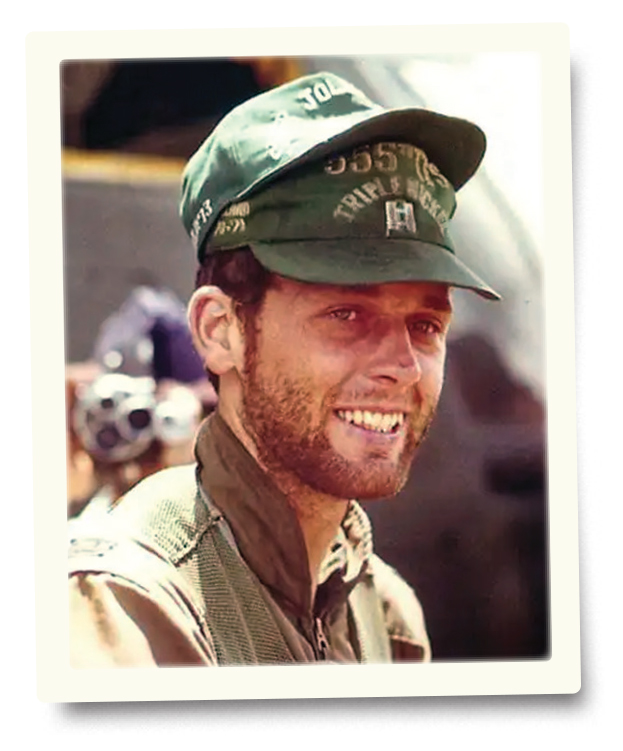
There was an additional coda to the Air Force’s dogfight. On June 1 Ritchie was flying near Yen Bai when he picked up a radio message: “Any U.S. Aircraft—this is Oyster-Zero-Zero-Bravo—over.” “We don’t have an Oyster call sign today,” Ritchie thought, “but then we realized, ‘My God, that’s Roger Locher!’ We answered, and Roger said: ‘Hey, guys, I’ve been down here a long time. Any chance of picking me up?’”
Although only five miles from the enemy airfield, Locher had somehow evaded capture. The next morning Gen. John W. Vogt Jr., commander of Air Forces in Vietnam and Thailand, canceled a bombing mission to Hanoi and committed 119 aircraft to cover the search and rescue operation that succeeded in extracting Locher by helicopter after a record 23 days in enemy territory.
Chasing an F-4
At 12:19 p.m. the U.S. Navy returned as Constellation launched an Alpha strike on Hai Duong rail yard, followed at 12:30 by one from Coral Sea. They were greeted by 85mm AAA as well as two GCI-directed MiG-21PFMs of the 927th FR, flown by Lts. Le Thanh Dao and Vu Van Hop. Le Thanh Dao, a veteran with one and one shared claim while serving in the 921st before being assigned to the 927th’s training cadre, described what ensued when they spotted two F-4s 10 kilometers north of Hai Duong:
“One of them turned left and passed under my MiG, while the other turned back and went into a climb. Hop turned sharply and got on the tail of the second F-4. He fired an R-3S missile. He wanted to fire his second but saw the first had hit its target and that the F-4 was already on fire. Hop shouted, ‘He’s burning!’ Because of heavy fire from our AA units he was ordered to land at Kep. Meanwhile, I was chasing another F-4, and fired my first missile when the range was about 1,500 [meters]. I wanted to launch my second missile but saw my target was also on fire. I broke off and dived to low level and returned to Kep.”
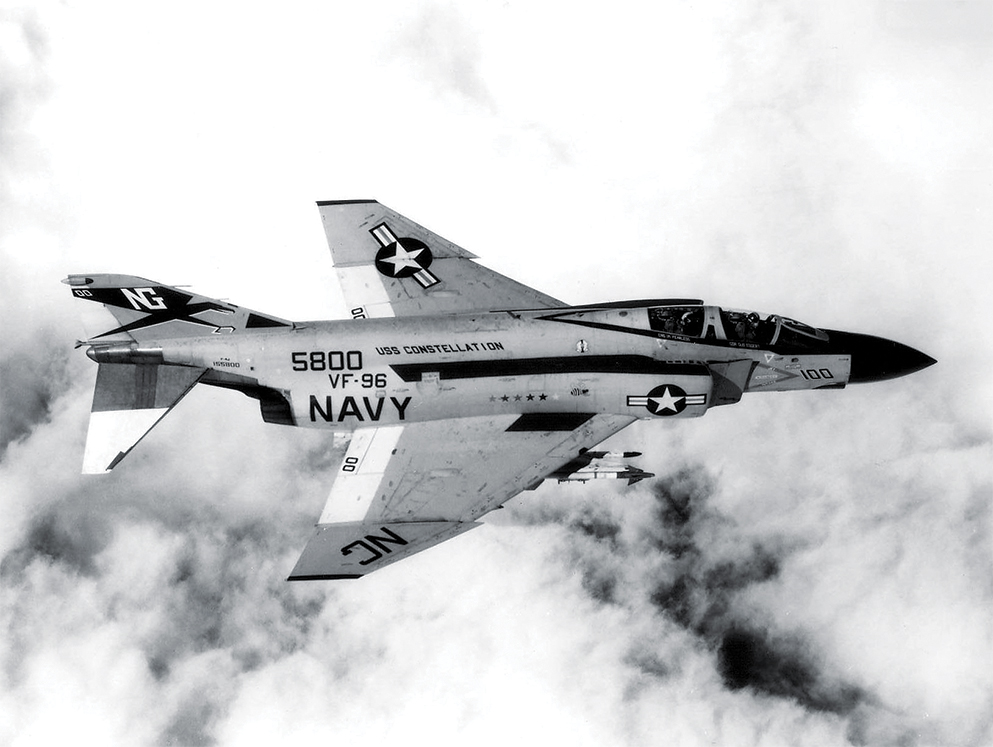
Le Thanh Dao was credited with what turned out to be an F-4J of Constellation’s VF-92, crewed by its executive officer, Cmdr. Harry Lee Blackburn Jr., and Lt. Stephen A. Rudloff. Both were captured. Rudloff was repatriated later, but the Vietnamese did not return Blackburn’s remains until April 10, 1986, never specifying how he died in captivity.
Vu Van Hop’s Phantom victory was credited as being crewed by Cunningham and Driscoll of VF-96. Although they took part in the mission, the duo was then part of the Alpha strike, not the MiGCAP, unable to take part in any dogfighting until they dropped their Rockeye bombs. Driscoll remembered seeing Blackburn and Rudloff go down and stated, “They rolled into the target right in front of us and flew into a nasty AAA barrage coming off target.” It seems more likely that Hop thought his missile downed the F-4J of Lt. Rod Dilworth and Lt. j.g. Jerry Hill, who were hit in their right engine—again, they claimed, from 85mm AAA—and loitered just long enough to spot Blackburn’s and Rudloff’s parachutes, thinking it was the same kill.
Cunningham, who witnessed Dilworth’s difficult retirement, noted: “On the way out, two MiG-21s made one pass at him and then let him go.” Though streaming fuel and jettisoning missiles to reach Constellation, Dilworth made an excellent single-engine deck landing, but his riddled Phantom was written off.
“Damn Good Airplane”
At 1:00 p.m. MiG-17s of the 923rd FR scrambled up from Kep to protect the bridgehead at Lai Vu and ran into Constellation’s strike force 15 kilometers from Hai Duong. Cunningham released his bombs about then, just in time to engage an oncoming MiG-17 while his wingmen, Lts. Brian Grant and Jerry Sullivan, fought another one. Loosing one of his Sidewinders at 2,500 feet distance, Cunningham saw his opponent explode. Still carrying ample fuel and missiles, he and Driscoll decided to try for another MiG.
Looking down, Cunningham saw eight MiG-17s in a defensive circle with three Phantoms among them. One of the F-4s, crewed by VF-96’s executive officer, Cmdr. Dwight D. Timm, and Lt. James Fox, broke from the circle with three MiGs in attendance. Going to their rescue, Cunningham made out two “MiG-19s” and four MiG-21s above them, “just cruising along, keeping an eye on the fight below.” Finally getting a tone on the MiG-17 nearest Timm’s plane, Cunningham fired another Sidewinder, which Fox said “traveled the entire length of the MiG, blowing him up. The pilot ejected right next to them.”
Then the four MiG-21s rolled in on the F-4s, but Cunningham evaded them and joined Timm in a race toward the coast. On the way, Cunningham spotted another MiG-17 and attacked it head-on—right into a barrage of 37mm and 23mm cannon fire. Cunningham pulled up into the vertical, expecting the MiG-17 pilot, whose plane dogfought more effectively in the horizontal plane, to quit while he was ahead. Instead, he found the MiG alongside him, canopy to canopy, matching his every maneuver in a series of climbs, dives, and scissor maneuvers. Cunningham thought, “He was flying [a] damn good airplane!”
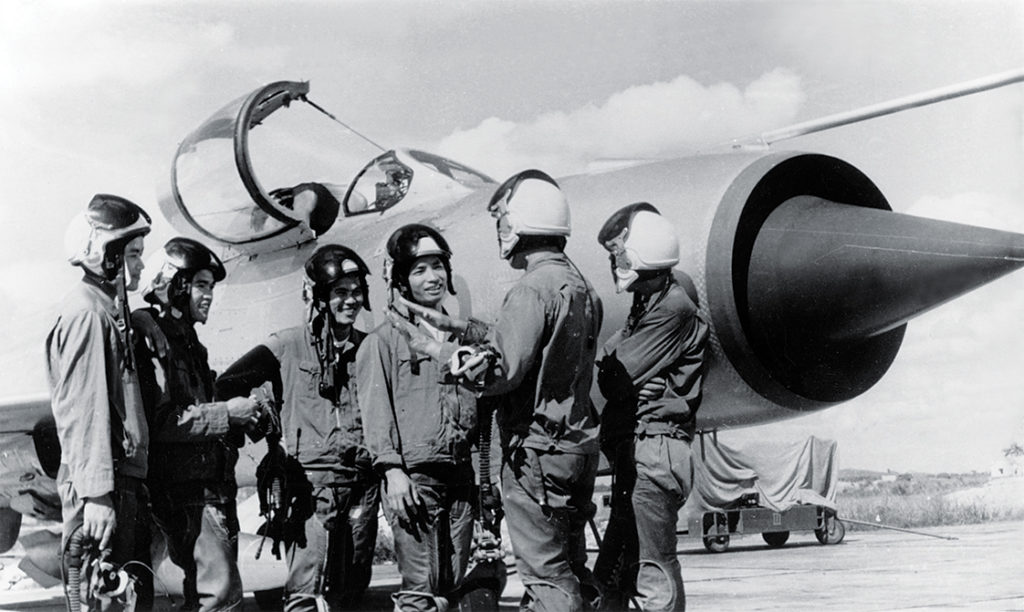
Their speed bled down to 150 knots—more the MiG-17’s element than a Phantom’s—but at that point the MiG broke off and dived, undoubtedly low on fuel or ammunition. Cunningham pursued it, fired off one Sidewinder and saw the MiG erupt in flame. “He didn’t seem to go out of control,” Cunningham recalled, “but he flew straight down to the ground. He didn’t get out.”
Besides the three MiG-17s that made Cunningham and Driscoll the first American Vietnam War aces, two others were credited to VF-96’s Lts. Michael J. Connelly and Thomas J.J. Blonski, and one to Lt. Steven C. Shoemaker and Lt. j.g. Keith V. Crenshaw. A seventh MiG-17 was credited to a Phantom crew from Coral Sea’s VF-51, Lts. Kenneth L. Cannon and Roy A. Morris.
Information that has turned up from the VPAF mentions four MiG-17 pilots taking off from Kep. Ta Dong Trung missed an enemy plane. Nguyen Van Tho missed an A-7 and later engaged an F-4 until his ammunition gave out and he was hit by a missile, ejecting northwest of Tu Ky. Tra Van Kien was killed by Cunningham and Driscoll. The fourth pilot, Do Hang, ejected after his MiG was hit by two AAMs but was killed by 20mm gunfire as he parachuted down—by two Phantoms, claim the North Vietnamese, but more likely by their own ground fire, since Navy F-4Js didn’t mount guns.
Downed By A SAM
After scoring their fifth MiG kill, Cunningham and Driscoll dodged two SAMs and fought their way through two attacking MiG-21s and more MiG-17s before finally reporting—and both maintaining to this day—that their Phantom fell victim to a SAM. “It was about 400 feet away when it exploded,” Cunningham said, “and we had closer misses than that, so I wasn’t too concerned.”
A minute later, the F-4 yawed violently and Cunningham saw that “the PC-1 hydraulic system was indicating zero, and the PC-2 and utility systems were fluctuating.” Struggling to maintain control, he managed to fly a critical 20 miles to clear the coast and get as far as possible over the Gulf of Tonkin before he and Driscoll had to “abandon ship.” “Our ejection went smoothly,” Cunningham said, “and we were picked up from the Gulf of Tonkin by Marine helos from the USS Okinawa!”
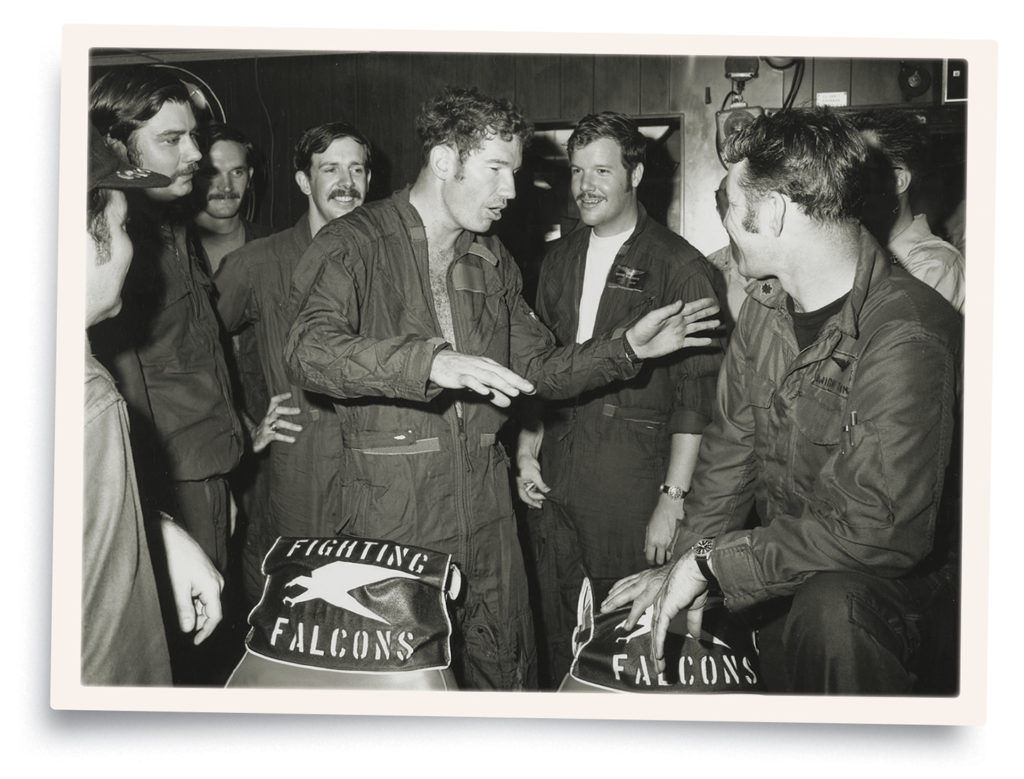
Le Thanh Dao survived the war with six victories to his credit. Vu Van Hop would not, being shot down on July 8 in one of two MiG-21PFMs credited to the soon-to-be USAF ace team of Steve Ritchie and Chuck DeBellevue. In a bizarre coincidence, Dang Ngoc Nhu was also killed on July 8, credited to Capts. Richard F. Hardy and Paul T. Lewinski of the 4th TFS, 366th TFW.
At 3:45 p.m. Constellation launched a third Alpha strike on the port of Hon Gai. At 3:55 Coral Sea’s aircraft attacked the railroad and highway bridge at Cam Pha, followed at 4:00 by Kitty Hawk’s last Alpha strike of the day. VF-92’s Curt Dosé, escorting an Iron Hand run, was pursued by two SAMs that passed close to his F-4J but failed to explode. Lieutenants John Anderson and Les Roy had a similar brush with SAMs, which also didn’t explode.
Thus ended one of the largest air battles, and certainly the most ferocious, of the Vietnam War. The Americans claimed 11 MiGs for the loss of six Phantoms, only two of which they acknowledged as air-to-air losses—both victims of 30mm cannon fire from obsolescent J-6s. The VPAF claimed four F-4s for the loss of three MiG-21s, anywhere from three to seven MiG-17s, and one J-6 in combat. However, despite their two aerial victories, more of the J-6s were lost in landing accidents, with at least three fatalities.
As both sides went over their after-action reports and pondered how to parlay lessons learned into revised tactics, plans were made for the next day’s missions. This was only the start of five months of further confrontations between North Vietnam’s defensive triad and the newest in American technology that distinguished Operation Linebacker.

